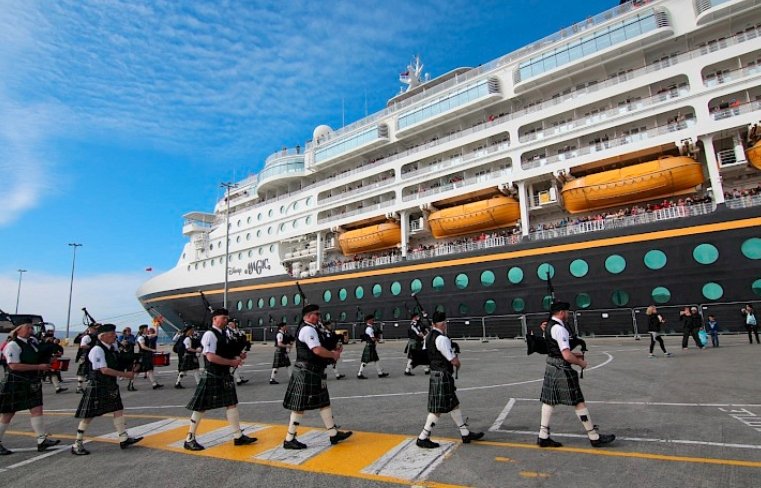Scotland is stepping up alongside Japan, Italy, Greece, Mexico, and others by planning a new tourism tax aimed at cruise passengers. The move targets mounting pressures on infrastructure and local communities, particularly in hotspots like the Orkney Islands, where visitor numbers have surged far beyond what the small population can handle.
This decision signals a shift in how popular cruise destinations deal with overtourism, focusing on sustainability and fairness as more tourists arrive by sea.
Orkney’s Overwhelmed Streets Spark Urgent Calls for a Cruise Tax
The Orkney Islands, off Scotland’s northeast coast, are famous for their rich history and stunning landscapes. But with about 450,000 visitors annually—half arriving on cruise ships—Orkney is feeling the squeeze. On busy summer days, more than 6,000 cruise passengers disembark, crowding narrow roads and historic sites, pushing local services to their limits.
Though tourism pumps roughly £12–15 million into the local economy yearly, the pressure is clear: congestion, wear on public spaces, and a strain on infrastructure have local officials sounding the alarm.
Small community shops and cafes, once quiet hubs, now buzz with visitors but also risk losing their charm under constant tourist influx.
The council recently gained new powers from the Visitor Levy (Scotland) Act 2024, allowing it to propose a tax specifically targeting cruise passengers who disembark for short visits. Though the exact levy amount hasn’t been finalized, the plan represents a big policy change in tackling overtourism head-on.

What the Cruise Tax Could Mean for Visitors and Operators
Cruise companies and travelers alike are watching the situation closely. Post-pandemic, the global cruise industry has been making a comeback, especially in Northern Europe. But past proposals elsewhere, like a $42 per passenger tax in Mexico, sparked fears of travel slowdowns and route cancellations.
If Orkney introduces this levy, other UK ports might follow, changing the cruising game in the region.
Cruise lines might adjust prices or reroute ships to avoid new fees, while passengers could see extra costs sneak into their trip budgets. It’s a delicate balance—raising funds for upkeep and preservation without driving tourists away.
Orkney’s local consultation on the levy closes May 30, 2025, with the council aiming to potentially start charging by the 2026 cruise season.
-
Funds collected would be reinvested directly into services strained by the influx:
-
Road repairs and traffic management
-
Restroom maintenance and expansion
-
Heritage site preservation
-
Public signage and transportation support
-
| Potential Impacts | Positive Outcomes | Possible Challenges |
|---|---|---|
| Revenue generation | Improved infrastructure and visitor experience | Higher travel costs for passengers |
| Preservation of heritage | Protects fragile sites from overuse | Cruise lines may change routes |
| Community support | Funds for local services | Risk of fewer cruise calls |
Scotland isn’t alone in this. Countries like Japan, the Netherlands, Italy, Greece, Mexico, and Portugal have also introduced or considered similar levies for cruise tourists.
Cities such as Venice have added tourist entry fees. Amsterdam has imposed stricter controls on cruise berths. Popular spots like Santorini, Barcelona, and Dubrovnik debate visitor limits due to overtourism’s impacts.
The phrase “overtourism” has moved from buzzword to urgent issue. The strain on local resources, cultural sites, and residents can no longer be ignored. Ports worldwide are experimenting with ways to manage visitor numbers while keeping tourism vibrant and sustainable.
Scotland’s decision to join this cohort sends a message: tourism is welcome, but the cost of doing nothing is too high.
The Delicate Dance Between Economic Boost and Environmental Care
Tourism, especially cruise tourism, brings jobs and business opportunities to places like Orkney. Yet, the rapid growth comes with downsides that threaten the very assets drawing visitors.
Orkney’s council faces a tough task: How to protect the islands’ heritage and natural beauty without stifling the economy?
The visitor levy aims to strike that balance. By charging cruise passengers directly, the revenue stream can help fund essential upkeep and reduce damage caused by the crowds.
But locals worry about the long-term effects. Will fewer cruise ships dock? Will tourists opt for other destinations? It’s a risk that many small communities face when imposing new fees.
One thing is certain—doing nothing risks losing the unique character and quality of life that make places like Orkney special.
What’s Next for Scotland’s Cruise Ports?
The Scottish Government itself isn’t pushing a national cruise tax but supports local councils’ rights to act where needed. That decentralized approach puts the spotlight on Orkney, which could become the test case for the UK.
With public consultation ongoing until the end of May, all eyes are on the islands. Cruise lines, residents, and tourism advocates are weighing in, hoping for a solution that benefits all.
If Orkney succeeds, it might inspire other Scottish and UK ports to follow suit—changing how cruise tourism is managed across the country.
For travelers dreaming of Northern Europe’s shores, this could mean new fees and adjustments soon. But it also means better protected heritage sites and improved visitor experiences down the line.
The cruise industry is at a crossroads, and Scotland is right in the thick of it.


















